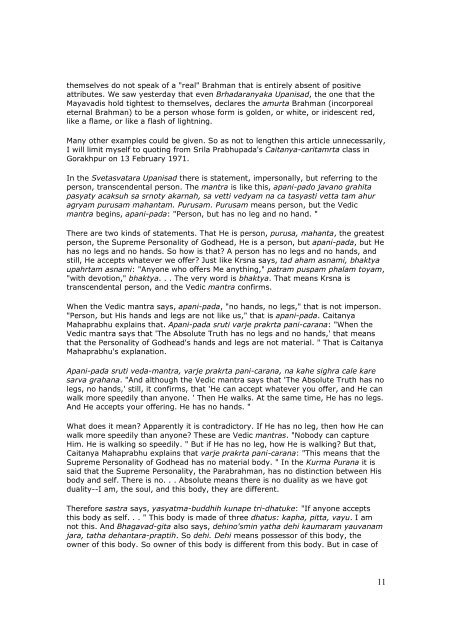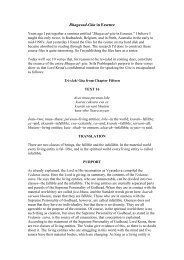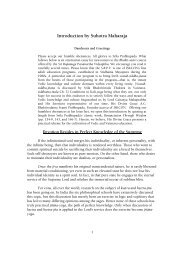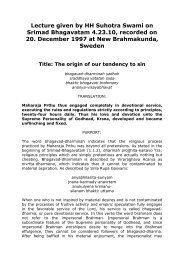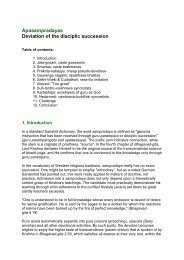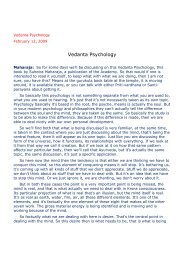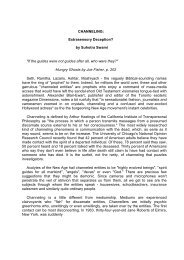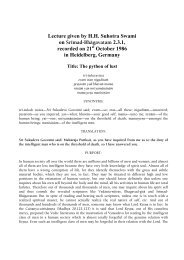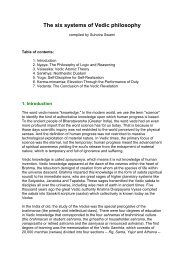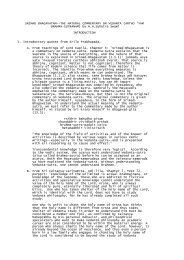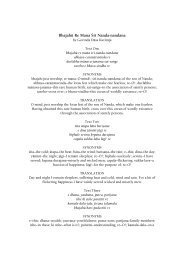What The Upanisads Teach.pdf - Suhotra Maharaja Archives
What The Upanisads Teach.pdf - Suhotra Maharaja Archives
What The Upanisads Teach.pdf - Suhotra Maharaja Archives
You also want an ePaper? Increase the reach of your titles
YUMPU automatically turns print PDFs into web optimized ePapers that Google loves.
themselves do not speak of a "real" Brahman that is entirely absent of positiveattributes. We saw yesterday that even Brhadaranyaka Upanisad, the one that theMayavadis hold tightest to themselves, declares the amurta Brahman (incorporealeternal Brahman) to be a person whose form is golden, or white, or iridescent red,like a flame, or like a flash of lightning.Many other examples could be given. So as not to lengthen this article unnecessarily,I will limit myself to quoting from Srila Prabhupada's Caitanya-caritamrta class inGorakhpur on 13 February 1971.In the Svetasvatara Upanisad there is statement, impersonally, but referring to theperson, transcendental person. <strong>The</strong> mantra is like this, apani-pado javano grahitapasyaty acaksuh sa srnoty akarnah, sa vetti vedyam na ca tasyasti vetta tam ahuragryam purusam mahantam. Purusam. Purusam means person, but the Vedicmantra begins, apani-pada: "Person, but has no leg and no hand. "<strong>The</strong>re are two kinds of statements. That He is person, purusa, mahanta, the greatestperson, the Supreme Personality of Godhead, He is a person, but apani-pada, but Hehas no legs and no hands. So how is that? A person has no legs and no hands, andstill, He accepts whatever we offer? Just like Krsna says, tad aham asnami, bhaktyaupahrtam asnami: "Anyone who offers Me anything," patram puspam phalam toyam,"with devotion," bhaktya. . . <strong>The</strong> very word is bhaktya. That means Krsna istranscendental person, and the Vedic mantra confirms.When the Vedic mantra says, apani-pada, "no hands, no legs," that is not imperson."Person, but His hands and legs are not like us," that is apani-pada. CaitanyaMahaprabhu explains that. Apani-pada sruti varje prakrta pani-carana: "When theVedic mantra says that '<strong>The</strong> Absolute Truth has no legs and no hands,' that meansthat the Personality of Godhead's hands and legs are not material. " That is CaitanyaMahaprabhu's explanation.Apani-pada sruti veda-mantra, varje prakrta pani-carana, na kahe sighra cale karesarva grahana. "And although the Vedic mantra says that '<strong>The</strong> Absolute Truth has nolegs, no hands,' still, it confirms, that 'He can accept whatever you offer, and He canwalk more speedily than anyone. ' <strong>The</strong>n He walks. At the same time, He has no legs.And He accepts your offering. He has no hands. "<strong>What</strong> does it mean? Apparently it is contradictory. If He has no leg, then how He canwalk more speedily than anyone? <strong>The</strong>se are Vedic mantras. "Nobody can captureHim. He is walking so speedily. " But if He has no leg, how He is walking? But that,Caitanya Mahaprabhu explains that varje prakrta pani-carana: "This means that theSupreme Personality of Godhead has no material body. " In the Kurma Purana it issaid that the Supreme Personality, the Parabrahman, has no distinction between Hisbody and self. <strong>The</strong>re is no. . . Absolute means there is no duality as we have gotduality--I am, the soul, and this body, they are different.<strong>The</strong>refore sastra says, yasyatma-buddhih kunape tri-dhatuke: "If anyone acceptsthis body as self. . . " This body is made of three dhatus: kapha, pitta, vayu. I amnot this. And Bhagavad-gita also says, dehino'smin yatha dehi kaumaram yauvanamjara, tatha dehantara-praptih. So dehi. Dehi means possessor of this body, theowner of this body. So owner of this body is different from this body. But in case of11


